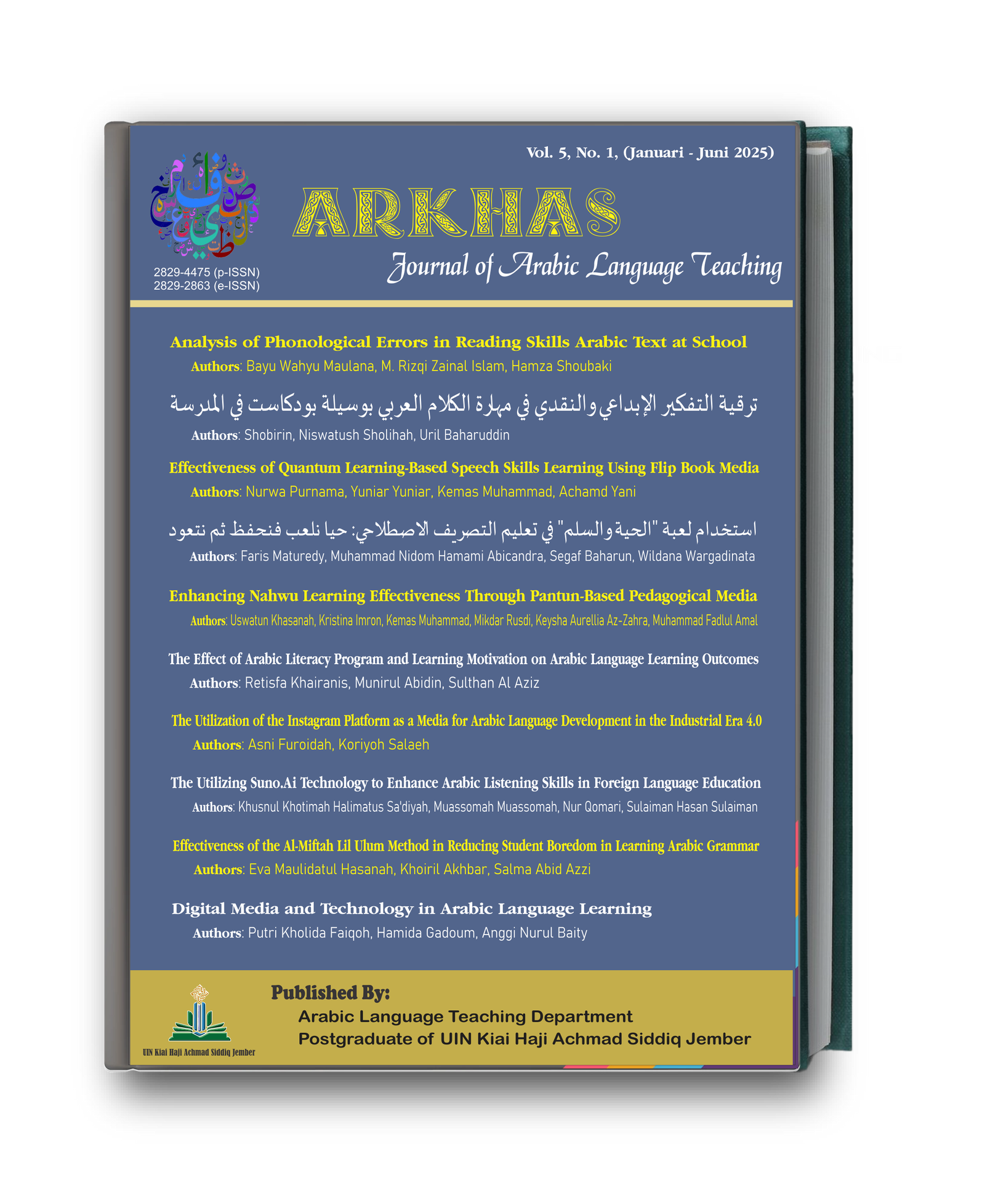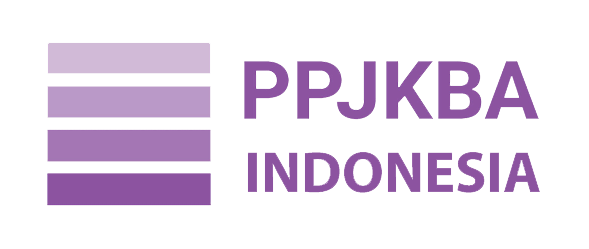Digital Media and Technology in Arabic Language Learning
DOI:
https://doi.org/10.35719/arkhas.v5i1.2263Keywords:
Arabic Language Learning, Media and Technology, IntegrationAbstract
Media and technology have brought significant transformations in Arabic language learning, creating new opportunities to improve the quality, accessibility and effectiveness of learning. This study uses a library research method to explore media and technology in Arabic language learning. Data were collected from various relevant written sources, including books, scientific journals, and online articles that discuss media and technology in language education. Various findings show that the integration of technologies, such as e-learning platforms, mobile applications, gamification, as well as Virtual Reality (VR) and Augmented Reality (AR), has successfully increased students' motivation, engagement, and Arabic language competence. Digital media not only makes learning more engaging and interactive, but also allows personalization of learning according to individual needs and learning pace. Some key recommendations include teacher training in the use of technology, development of quality digital content, and collaboration between the government, educational institutions and the private sector.
References
Agustin, B. N., & Bukhori, E. M. (2025). Integration of Interactive Lumio Media for the Development of Arabic Listening Skills in Islamic Senior High Schools. 9(1), 1–26. https://doi.org/10.29240/jba.v9i1.12441
AlSadrani, B., Alzyoudi, M., Alsheikh, N., & Elshazly, E. E. (2020). The Digital Divide in Inclusive Classrooms. International Journal of Learning, Teaching and Educational Research, 19(3), 69–85. https://doi.org/10.26803/ijlter.19.3.5
Anggraeni, Y., & Sujatmiko, B. (2021). Studi Literatur Pengaruh Penggunaan Gamifikasi Dalam Pembelajaran Ilmu Komputer Di Perguruan Tinggi. Jurnal IT-EDU, 05, 614–620.
Arifin, M. Z. (2022). The Traditionalism of the Islamic Boarding School Education System in the Era of Modernization. Scaffolding: Jurnal Pendidikan Islam Dan Multikulturalisme, 4(1), 286–396. https://doi.org/10.37680/scaffolding.v4i1.1367
Arsyad, A. (2011). Media Pembelajaran. PT Rajagrafindo Persada.
Ashari, M. Y., Huda, M. M., & Mahfudhoh, R. (2024). Enhancing Arabic Writing Skills Through the Genre-Based Approach in Senior High School. Journal of Arabic Language Teaching, 4(2), 121–134. https://doi.org/10.35719/arkhas.v4i2.2137
Asmawati, A., Asy’ari, A., & Malkan, M. (2020). Active Learning Strategies Implementation in Arabic Teaching at Senior High School. International Journal of Contemporary Islamic Education, 2(1), 1–20. https://doi.org/10.24239/ijcied.vol2.iss1.10
Atman Said, S. (n.d.). Pengelolaan Lingkungan Berbahasa Arab Dalam Meningkatkan Kemampuan Berbicara Siswa Madrasah Aliyah Insan Cendikia Halmahera Barat. Jurnal Ilmiah Wahana Pendidikan, Januari, 2022(1), 600–608. https://doi.org/10.5281/zenodo.7554152
Azhar, M., Wahyudi, H., Promadi, & Masrun. (2023). Penggunaan Teknologi dalam Pembelajaran Bahasa Arab di Indonesia. Jurnal Review Pendidikan Dan Pengajaran, 6(4), 3160–3164.
Bandura, A. (1977). Social Learning Theory. Englewood Cliffs, NJ: Prentice Hall.
Beetham, H., & Sharpe, R. (Eds. . (2013). Rethinking pedagogy for a digital age: Designing for 21st century learning. Routlegde.
Bruner, J. S. (1966). Toward a theory of instruction. Harvard University Press.
Chen, M. R. A., & Hwang, G. J. (2020). “Effects of gamification on language learning: A meta-analysis.” Educational Technology & Society, 23(3), 1–15.
Elnagar, A., Yagi, S. M., Nassif, A. B., Shahin, I., & Salloum, S. A. (2021). Systematic Literature Review of Dialectal Arabic: Identification and Detection. IEEE Access, 9, 31010–31042. https://doi.org/10.1109/ACCESS.2021.3059504
Farida, F. C., Achmad Irsyad Assiddiqi, Mokhammad Miftakhul Huda, & Faisol Nasar bin Madi. (2024). Analysis Of Arabic Teaching Books Of Ma Class Xi 2013 Curriculum Published 2020 Ri Ministry Of Religion. Lahjah Arabiyah: Jurnal Bahasa Arab Dan Pendidikan Bahasa Arab, 5(2), 194–210. https://doi.org/10.35316/lahjah.v5i2.194-210
Gagne, R. M. (1985). The Conditions of Learning and Theory of Instruction (4th ed.). Holt, Rinehart and Winston.
Hamari, J. (2013). Transforming homo economicus into homo ludens: A field experiment on gamification in a utilitarian peer-to-peer trading service. Electronic Commerce Research and Applications, 12(4), 236–245. https://doi.org/10.1016/j.elerap.2013.01.004
Heinich, R., Molenda, M., Russell, J. D., & Smaldino, S. E. (1999). Instructional media and technologies for learning. Upper Saddle River, NJ:1 Merrill Prentice Hall.
Huang, X., Zou, D., Cheng, G., Chen, X., & Xie, H. (2023). Trends, Research Issues and Applications of Artificial Intelligence in Language Education. Educational Technology & Society, 26(1), 112–131. https://www.jstor.org/stable/48707971
Keshav, M., Julien, L., & Miezel, J. (2022). The Role Of Technology In Era 5.0 In The Development Of Arabic Language In The World Of Education. Journal International of Lingua and Technology, 1(2), 79–98. https://doi.org/10.55849/jiltech.v1i2.85
Kohnke, L., Moorhouse, B. L., & Zou, D. (2024). ChatGPT for language teaching and learning. RELC Journal, 55(1), 1–12.
Mahmudah, M., Maghfiroh, L., Hanifansyah, N., & Syakur, S. A. (2025). Enhancing Arabic Rhetoric Education through Mind Mapping: A Focus on Bayan & Badi’. Lughawiyyat: Jurnal Pendidikan Bahasa Dan Sastra Arab, 8(1), 32–55. https://doi.org/10.38073/lughawiyyat.v8i1.2208
Musthafa, I., & Hermawan, A. (2018). Metodologi penelitian bahasa Arab : konsep dasar strategi metode teknik (K. E. (ed.)). Remaja Rosdakarya.
Muthmainnah, M., & Annas, A. (2020). Pemanfaatan “Vlog” Sebagai Media Pembelajaran dalam Meningkatkan Maharah Kalam bagi Mahasiswa IAIN Kudus. In Arabia (Vol. 12, Issue 2, p. 123). State Islamic College of Kudus. https://doi.org/10.21043/arabia.v12i2.8073
Ndubuisi, G., Otioma, C., & Tetteh, G. K. (2021). Digital infrastructure and employment in services: Evidence from Sub-Saharan African countries. Telecommunications Policy, 45(8), 102153. https://doi.org/10.1016/j.telpol.2021.102153
Nunan, D. (1999). Second Language Teaching & Learning. Heinle & Heinle Publishers.
Nur, F., Tamami, I., Hermawan, A., Islam, U., Sunan, N., & Djati Bandung, G. (2023). Perkembangan Teknologi Media Pembelajaran Bahasa Arab. Jurnal Pendidikan Bahasa Arab, 4(2), 158–178.
Parmaxi, A. (2023). Virtual reality in language learning: A systematic review and implications for research and practice. Interactive Learning Environments, 31(1), 172–184. https://doi.org/10.1080/10494820.2020.1765392
Prananingrum, A. V., Rois, I. N., & Sholikhah, A. (2020). Kajian Teoritis Media Pembelajaran Bahasa Arab. Konferensi Nasonal Bahasa Arab (KONASBARA), 3(1), 303–319.
Rani, S. A. (2017). Pembelajaran Bahasa Arab Berbasis Teknologi Informasi dan Komunikasi. AT-TA’DIB: JURNAL ILMIAH PRODI PENDIDIKAN AGAMA ISLAM, 9(2), 163–177. https://doi.org/https://ejournal.staindirundeng.ac.id/index.php/tadib/article/view/14
Reiser, R. A., & Dempsey, J. V. (2018). Trends and issues in instructional design and technology. Pearson.
Ritonga, M., Nazir, A., & Wahyuni, S. (2016). Pembelajaran Bahasa Arab Berbasis Teknologi Informasi Dan Komunikasi Di Kota Padang. Arabiyat : Jurnal Pendidikan Bahasa Arab Dan Kebahasaaraban, 3(1), 1–12. https://doi.org/10.15408/a.v3i1.2879
Sadiman, A. S. (2011). Media Pendidikan, Pengertian, Pengembangan, dan Pemanfaatannya Teknologi. PT. Raja Grafindo Persada.
Sholihah, E., Supardi, A., & Hilmi, I. (2019). Teknologi Media Pembelajaran Bahasa Arab. Jurnal Keislaman Dan Pendidikan, 1(2), 12–15.
Skinner, B. F. (1953). Science and Human Behavior. Macmillan.
Soleha, S., Bukhori, E. M., & Huda, M. M. (2025). T ransforming Student ’ s Arabic Writing Skills through Word Square Media : Examining its Effectiveness Transformasi Keterampilan Menulis Bahasa Arab Siswa melalui Media Word Square : Menguji Efektivitasnya. 08, 89–107. https://doi.org/10.30762/asalibuna.v8i02.5231
Sutaman, S., & Febriani, S. R. (2021). Optimizing Arabic Speaking Skills Based On Integration Of Learning Theory Framework In Higher Education. Arabiyat : Jurnal Pendidikan Bahasa Arab Dan Kebahasaaraban, 8(1), 75–89. https://doi.org/10.15408/a.v8i1.20423
Taufiq, W. (2018). Metode penelitian bahasa Arab (M. D. Wildani (ed.)). Refika Aditama.
Verawati Heniverawati, H. (2021). Heni Verawati & Uswatun Hasanah The Modern Reform of Arabic Learning Paradigm and Its’ Contribution toward the Development of Islamic Studies. 6(1).
Wright, T. (2010). Second language teacher education: Review of recent research on practice. Language Teaching, 43(3), 259–296. https://doi.org/10.1017/S0261444810000030
Xie, Y., Liu, Y., Zhang, F., & Zhou, P. (2022). Virtual Reality-Integrated Immersion-Based Teaching to English Language Learning Outcome. Frontiers in Psychology, 12(February), 1–10. https://doi.org/10.3389/fpsyg.2021.767363
Zikri, M., Mardiantara, L. H., & Aziz, A. (2024). Strategi Penggunaan Media dan Teknologi Dalam Pembelajaran Bahasa Arab. 9(2023), 2961–2966.
Zou, D., Huang, Y., & Xie, H. (2021). Digital game-based vocabulary learning: Where are we and where are we going? Computer Assisted Language Learning, 34(5), 751–777. https://doi.org/10.1080/09588221.2019.1640745
Zurqoni, Retnawati, H., Rahmatullah, S., Djidu, H., & Apino, E. (2020). Has arabic language learning been successfully implemented? International Journal of Instruction, 13(4), 715–730. https://doi.org/10.29333/iji.2020.13444a












